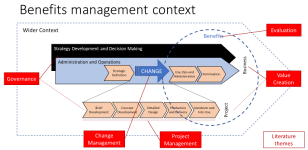
Posted by Eivind Tandberg[1]
The Norwegian research program Concept supports research related to the country’s public investment management framework. Concept recently published a working paper on how expected benefits are managed in large public investments. The paper reviewed the international literature on benefits management and looked at how the idea has been applied in practice in five major Norwegian investment projects.
The literature study showed that benefits management has been a topic of discussion since the 1950s, but the focus has increased significantly in recent decades. The basic idea is to establish project management approaches and procedures that help ensure that the benefits that were expected when a project was planned are realized when the project is completed. The theoretical literature about benefits management is to a large extent based on studies of the ICT sector, but these experiences are gradually being reflected in more general literature on project management. The conceptual framework for benefits management is unclear and there are different views on some key definitions, including the relationship between benefits management and project output realization. The figure below summarizes key concepts related to project benefits management.
Click on the figure for a better image resolution
The study defines benefits management as the management of primary project outcomes for direct users of infrastructure assets (for example, increased traffic, reduced travel times and reduced accidents on a new motorway) and secondary project impacts on communities and other external stakeholders (for example environmental and economic or “agglomeration” effects of the motorway). It proposes a set of principles for effective benefits management and assesses five major Norwegian government investment projects considering these principles. The projects were chosen because they were expected to provide practical examples of good benefits management but are not necessarily representative of all Norwegian public investment projects.
The analysis found that project teams put considerable emphasis on benefits management during the project implementation phase. Some of the projects had developed detailed expected benefits catalogues, and these were subject to monthly monitoring together with cost and physical progress. For these projects, project adjustment decisions reflected explicit and documented trade-offs between costs and expected benefits. However, there were weaknesses in documentation of the expected and realized benefits as well as lack of systematic benefits management when projects move from the planning phase to implementation. In most of the projects reviewed, it is also unclear how benefits management will be handled during the operational phase of the infrastructure asset. It is therefore not possible to see if benefits management is consistent and effective over time.
Recent developments in the Norwegian public investment management framework puts greater emphasis on benefits management, including through a new requirement for documentation of project adjustments and related impacts on expected project benefits in the transition from initial project planning to detailed project design. This study suggests further strengthening benefits management by extending the documentation requirements to follow project amendments and benefit changes throughout the project life cycle. This will help reduce current fragmentation and facilitate more consistent benefits management of projects over time.
The study was prepared for the Concept program by a team from Norwegian consultants Vista Analyse and WSP. The study is written in Norwegian and is available here.
[1] Infrastructure Governance Advisor, Fiscal Affairs Department, IMF.
Note: The posts on the IMF PFM Blog should not be reported as representing the views of the IMF. The views expressed are those of the authors and do not necessarily represent those of the IMF or IMF policy.






